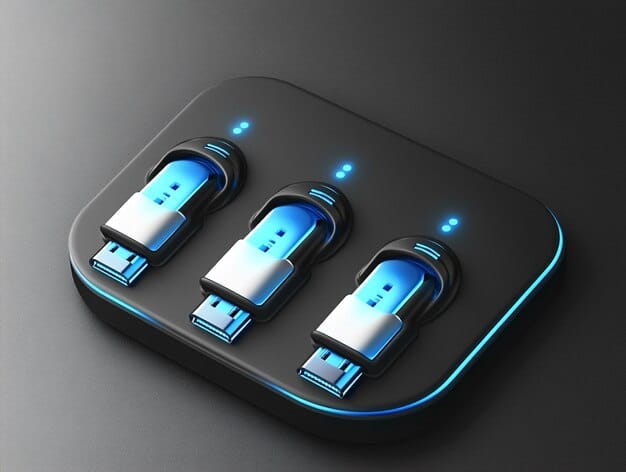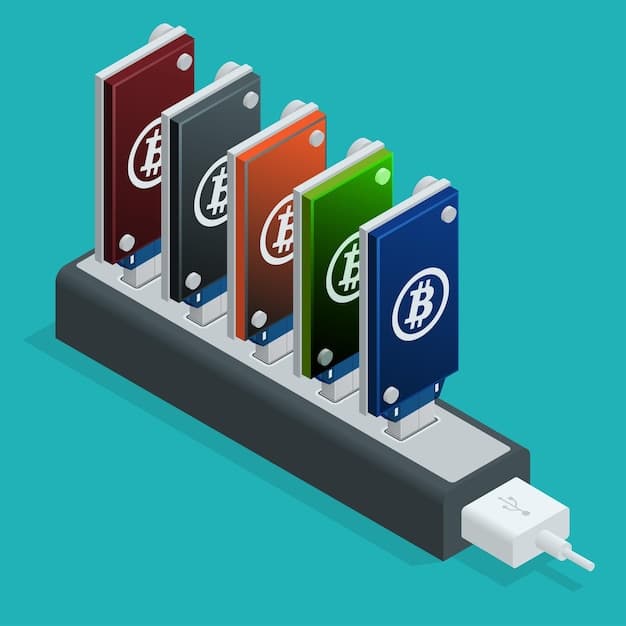USB4 in 2025: Understanding the New Data Transfer Standard

Understanding the New USB4 Standard: What It Means for Data Transfer Speeds in 2025 involves recognizing its enhanced bandwidth, versatile connectivity, and improved power delivery, promising faster data transfer rates and simplified device compatibility in the evolving tech landscape.
Get ready for a significant leap in data transfer technology! Understanding the New USB4 Standard: What It Means for Data Transfer Speeds in 2025 is crucial as we anticipate the next wave of devices hitting the market. Let’s explore what this advancement holds for the future of connectivity.
The Evolution of USB: A Quick Recap
Before diving into the specifics of USB4, it’s essential to understand how USB technology has evolved over the years. From its humble beginnings, USB has become a ubiquitous standard for connecting devices.
USB 1.0 and 2.0: The Early Days
The original USB standards, 1.0 and 2.0, laid the foundation for what USB would become. While their data transfer speeds were relatively slow by today’s standards, they provided a universal interface for connecting peripherals.
USB 3.0 and 3.1: A Significant Speed Boost
USB 3.0 brought a significant increase in data transfer speeds, followed by USB 3.1, which further enhanced performance. These standards introduced the familiar blue USB ports, signaling their faster capabilities.

- USB 1.0: Introduced in 1996, offering a maximum data transfer rate of 12 Mbps.
- USB 2.0: Released in 2000, significantly increasing speeds to 480 Mbps.
- USB 3.0: Arrived in 2008, boosting speeds to 5 Gbps and introducing the blue connector.
- USB 3.1: Further enhanced speeds to 10 Gbps, paving the way for USB-C connectors.
In summary, the evolution of USB has been marked by continuous improvements in data transfer speeds and connectivity, setting the stage for the revolutionary USB4 standard.
What is USB4 and Why Does It Matter?
USB4 represents a major step forward in USB technology. It’s not just about faster speeds; it’s about more efficient and versatile connectivity.
Adopting the Thunderbolt Protocol
One of the key features of USB4 is its adoption of the Thunderbolt protocol. This allows for significant increases in data transfer speeds and improved compatibility with other devices.
Increased Bandwidth and Speed
USB4 boasts a theoretical maximum bandwidth of 40 Gbps, doubling the speeds of its predecessor, USB 3.2. This means faster file transfers, smoother video streaming, and improved performance for external devices.
- Higher Data Transfer Rates: Significantly reduces the time required to transfer large files.
- Improved Video Performance: Supports high-resolution displays and external GPUs with ease.
- Enhanced Device Compatibility: Works seamlessly with a wide range of devices, thanks to Thunderbolt integration.
USB4 marks a paradigm shift in connectivity, offering unprecedented speeds and versatility for a wide array of applications and devices. Its adoption signifies a move towards more streamlined and efficient data transfer solutions.

Key Features and Benefits of USB4
USB4 comes with a range of features and benefits that make it a compelling upgrade for both consumers and manufacturers.
Backward Compatibility
Despite its advanced capabilities, USB4 maintains backward compatibility with older USB standards. This means you can still use your existing USB devices with USB4 ports, albeit at their original speeds.
Power Delivery Enhancements
USB4 also improves upon power delivery capabilities, allowing for faster charging of devices and more efficient power management. This is particularly beneficial for laptops and other portable devices.
Simplified Connectivity
With USB4, connectivity becomes simpler and more streamlined. The adoption of the USB-C connector as the primary interface further enhances this simplicity, reducing cable clutter and confusion.
In conclusion, USB4’s key features, including backward compatibility, enhanced power delivery, and simplified connectivity, position it as a comprehensive solution for modern data transfer needs.
USB4 vs. Thunderbolt 3: What’s the Difference?
While USB4 incorporates Thunderbolt technology, there are still some key differences between the two standards.
Mandatory vs. Optional Features
One of the primary distinctions is that certain features that are mandatory in Thunderbolt 3 are optional in USB4. This can lead to variations in performance and capabilities across different USB4 devices.
Certification and Compliance
Thunderbolt 3 devices undergo rigorous certification processes to ensure consistent performance. USB4 devices, on the other hand, may not always meet the same level of scrutiny, potentially resulting in inconsistencies.
Cost Considerations
Thunderbolt 3 devices tend to be more expensive due to the higher certification standards and advanced features. USB4 devices, with their more flexible implementation, may offer a more cost-effective alternative.
In summary, while USB4 leverages Thunderbolt 3 technology, key differences in mandatory features, certification, and cost distinguish the two standards, impacting performance consistency and price points.
The Impact of USB4 on Data Transfer Speeds in 2025
By 2025, USB4 is expected to have a significant impact on data transfer speeds and overall device performance.
Faster File Transfers
The increased bandwidth of USB4 will enable much faster file transfers, reducing the time it takes to copy large files between devices. This will be particularly beneficial for professionals working with large media files.
Improved External Storage Performance
External storage devices connected via USB4 will experience a significant performance boost, allowing them to operate at speeds closer to internal storage drives. This will make external storage a more viable option for demanding applications.
Enhanced Display Capabilities
USB4’s ability to handle high-resolution video signals will enable improved display capabilities, allowing for seamless connectivity to external monitors and displays. This will be particularly beneficial for gamers and creative professionals.
Ultimately, USB4’s impact on data transfer speeds in 2025 will lead to faster file transfers, improved external storage performance, and enhanced display capabilities, transforming the user experience across various applications.
Future Trends and Developments for USB4
Looking ahead, there are several trends and developments to watch for in the realm of USB4 technology.
Increased Adoption
As more devices adopt USB4, the standard will become more prevalent in the market. This will lead to greater compatibility and interoperability between devices.
Further Speed Enhancements
Future iterations of USB4 are likely to push the boundaries of data transfer speeds even further. The USB Implementers Forum (USB-IF) is constantly working on new standards to meet the evolving needs of the industry.
Integration with Other Technologies
USB4 is expected to become increasingly integrated with other technologies, such as wireless charging and augmented reality. This will lead to new and innovative use cases for the standard.
In conclusion, the future of USB4 holds promise with increased adoption, further speed enhancements, and integration with other technologies, driving innovation and shaping the future of connectivity.
| Key Aspect | Brief Description |
|---|---|
| 🚀 Speed Boost | Doubles data transfer rates to 40 Gbps, enhancing file transfers. |
| 💡 Thunderbolt Integration | Adopts the Thunderbolt protocol for improved performance. |
| 🔄 Backward Compatibility | Works with older USB devices, ensuring seamless transition. |
| ⚡ Enhanced Power | Improves power delivery for faster device charging. |
Frequently Asked Questions (FAQ)
▼
USB4 doubles the data transfer rate compared to USB 3.2, reaching up to 40 Gbps, and incorporates Thunderbolt technology for enhanced performance and compatibility with a wider range of devices.
▼
Yes, USB4 maintains backward compatibility with previous USB standards, such as USB 3.2 and USB 2.0. This ensures that older devices can still be used with USB4 ports, albeit at their original speeds.
▼
While USB4 incorporates Thunderbolt technology, it doesn’t necessarily make Thunderbolt 3 obsolete. Thunderbolt 3 still offers certain mandatory features and certification standards that may provide benefits for specific applications.
▼
For gamers, USB4 offers improved display capabilities, faster file transfers, and enhanced performance for external storage devices. This results in smoother gaming experiences and quicker loading times.
▼
By 2025, USB4 is expected to become a prevalent standard, simplifying connectivity and improving data transfer speeds across a wide range of devices. This will lead to a more streamlined and efficient user experience.
Conclusion
Understanding the New USB4 Standard: What It Means for Data Transfer Speeds in 2025 is essential for anyone looking to stay ahead in the tech world. With its impressive speed enhancements, Thunderbolt integration, and streamlined connectivity, USB4 is set to redefine how we connect and interact with our devices, making it a crucial development to watch in the coming years.





